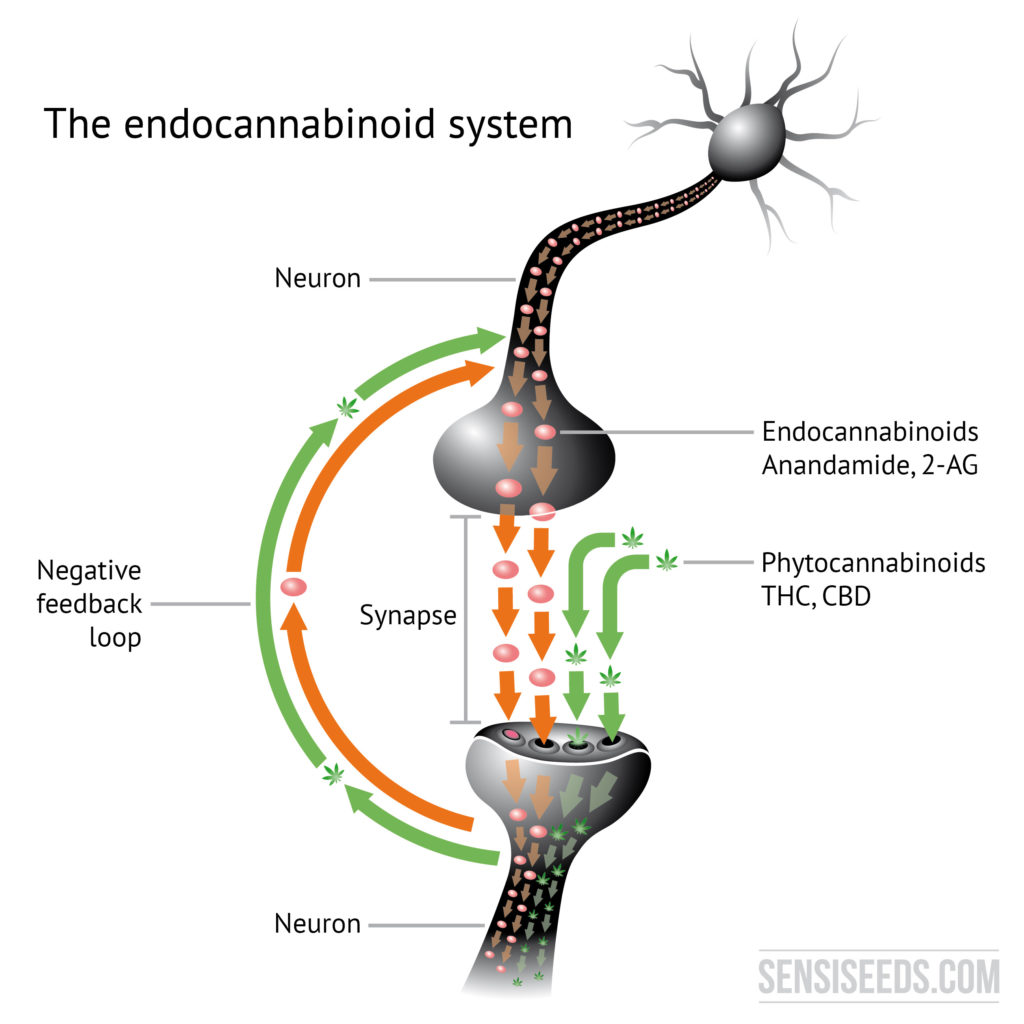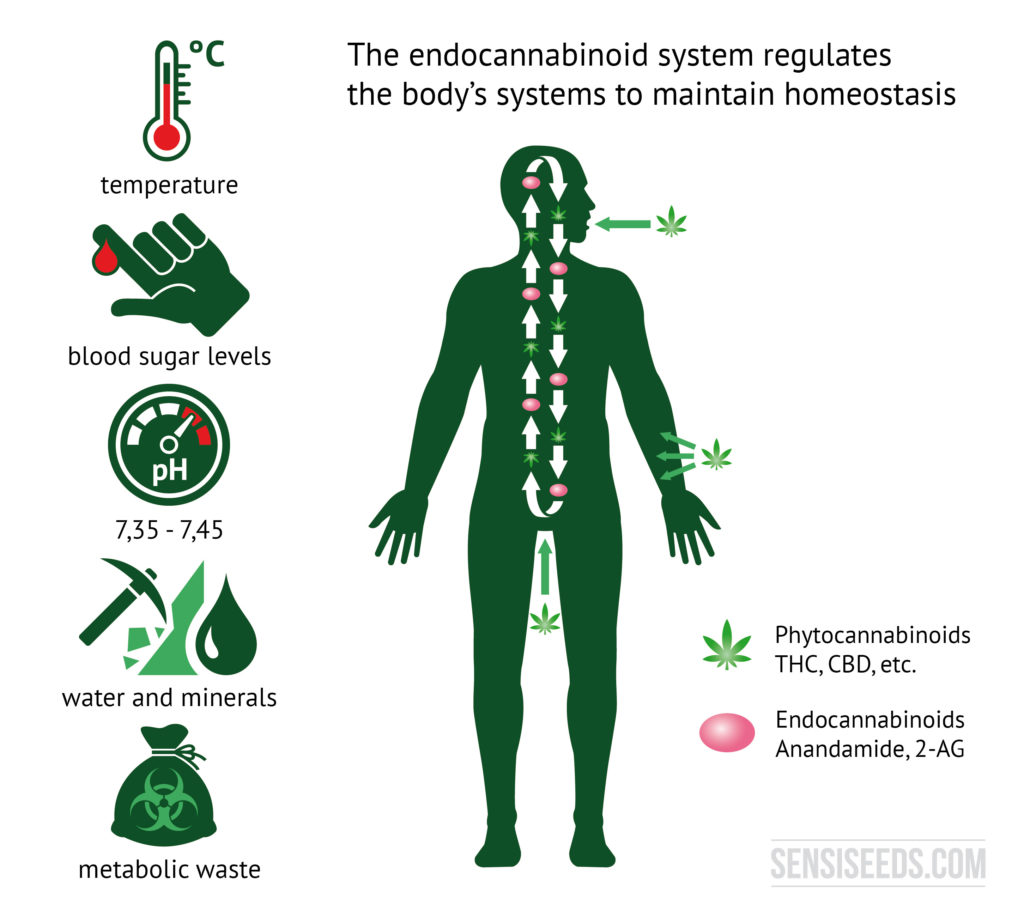What Is The Endocannabinoid System And How Does It Work? A Beginner’s Guide
endocannabinoid system
Simply put, the endocannabinoid system is an essential biological network similar to the central nervous system, in that it is vital to the healthy functioning of bodies and it is not restricted to one organ or body part. Amazingly, it was discovered thanks to cannabis use and users, so don’t believe anyone saying we never contribute anything to society!
What is the endocannabinoid system?
The endocannabinoid system is, scientifically speaking, made up of neurons, endocannabinoids and cannabinoid receptors. This article is going to break this statement down into simpler terms, as this is fascinating stuff, but requires some explanation for pretty much everyone who hasn’t studied neuroscience (this includes the writer!).
There are nerve cells called neurons throughout the brain and body which are linked together by neurotransmitters. These neurotransmitters are molecules called agonists that move from one neuron to another through the minute space between them, which is called the synapse.
The agonists plug into neural receptors, causing a chain reaction. In the case of the endocannabinoid system, these receptors are called CB1 (Cannabinoid receptor 1) and CB2 (Cannabinoid receptor 2).
CB1 receptors are mainly found in the brain, with some in the liver, lungs, and kidneys. CB2 receptors are found throughout the body. There are more cannabinoid receptors in the brain than any other type of neural receptor.
A common analogy is that the agonists are keys and the receptors are locks. However, you can also think of the neurons as being like Lego blocks, with the studs* as agonists and the tubes* as receptors. The endocannabinoid system is a structure. It can only work if the blocks fit together. And as you’ll see, it’s essential that it does work!
Endocannabinoid system sends signals within the brain and around the body
Cannabinoids transmit signals from one neuron to another
CB1 = cannabinoid receptor 1. Location: Mostly brain
CB2 = cannabinoid receptor 2. Location: Body
How does the endocannabinoid system work?
The endocannabinoid system is activated by (surprise, surprise) cannabinoids. The cannabinoids naturally produced by the body, which are known as endocannabinoids; and the cannabinoids found in cannabis, which are known as phytocannabinoids.
The key and lock analogy mentioned above is based upon the CB1 and CB2 receptors only being activated by cannabinoids, not any other type of agonist molecule. The cannabinoid ‘keys’ are the only ones that will fit the receptor ‘locks’.
Diagram showing two neurons that are connected to each other by means of a synapse. This results in a negative feedback mechanism, which is significant in connection with the endocannabinoid system.
Phyto = prefix meaning a plant or plants
Endo = prefix meaning within or inside
Phytocannabinoids, also called classic cannabinoids, come from plants
Endocannabinoids come from inside the body
The CB1 receptors are activated by THC (tetrahydrocannabinoid) – so when we talk about the ‘headrush’ effect caused by sativa-dominant, THC-heavy strains, there’s a literal quality to that statement!
The CB2 receptors are activated by CBD (cannabidiol), which is not psychoactive and more associated with cannabis strains (and pure CBD products) that give a relaxing, body-centric effect. This makes the location of, and difference between, the two receptors easy to remember!
CB1 = THC = head
CB2 = CBD = body
What is the endocannabinoid system for?
The endocannabinoid system regulates the body’s systems to maintain homeostasis: the state of balance necessary for healthy function. Homeostasis can be thought of as the narrow range of states within which bodies work as they should.
For example, the blood sugar levels, internal temperature, pH levels of blood, regulation of the amount of water and minerals in the body, and the removal of metabolic waste, are all governed by homeostatic processes.
A simple analogy is to think of the body as a house, and the endocannabinoid system as the caretaker inside.
If the house is too hot, the caretaker opens the windows or turns on the air conditioning. If the house is too cold, the caretaker closes the windows and turns on the heating. If the house becomes dirty, the caretaker cleans it, but also knows when to stop cleaning it – you wouldn’t throw away all the rubbish and then start on the furniture.
Body = house
Endocannabinoid system = caretaker
Cannabinoids = messages the caretaker receives about what needs to be done
Explanatory diagram of the endocannabinoid system. On the left side of the diagram are illustrations that represent the body temperature, the blood glucose level, the pH value, the water and mineral management and the metabolic end products. To the right is the outline of a human being. Phytocannabinoids enter the body through the mouth and skin, as can be seen in the diagram.
Most agonists only travel in one direction. Cannabinoids are unusual in that they can travel both ways between neurons. This is known as a negative feedback loop. It is what makes the ECS such an essential system for lifeforms. It tells the body when to begin a process (for example, sweating to cool down) but also when to stop it (otherwise we’d all be sweating constantly).
Bodies constantly make their own cannabinoids (endocannabinoids) to interact with their endocannabinoid system, ensuring that homeostasis continues.
If not enough endocannabinoids are created, it is thought that clinical endocannabinoid deficiency may occur. It is also thought that this can be treated by introducing phytocannabinoids, something that humanity has been doing with varying degrees of therapeutic success since before recorded history.
The reason cannabis can treat so many different conditions is that the endocannabinoid system is spread throughout the body and responsible for the correct functioning of so many different parts and aspects of it.
Are humans the only ones with endocannabinoid systems?
Absolutely not! The reason this article refers to ‘the body’ rather than ‘the human body’ is that more creatures on this planet have an ECS than not.
All vertebrates (creatures with a backbone) and invertebrates (creatures without a backbone) have one. This explains why CBD products are having such success when used on pets, and have the potential to treat a virtually unlimited number of species.
There are a few species that don’t have one, such as sea sponges, nematode worms and anemones, since their evolution diverged from ours so long ago. The earliest lifeform known to have cannabinoid receptors is the sea-squirt.
This primitive tube-shaped creature evolved more than 600 million years ago, and vomits up its internal organs as a self-defence move (rather like very drunk people avoiding pub brawls). There is even a type of slime mould that “possesses a rudimentary endocannabinoid system”.
When was the endocannabinoid system discovered?
You might think that, since the ECS is so ancient, so vital, and so common in lifeforms, it would have been discovered long ago. You would be wrong. The endocannabinoid system was only confirmed in the form that we know it today (CB1 and CB2 receptors, triggered by two known endocannabinoids) in 1995 (raise your hand if you’re older than this crucial discovery!).
1940 – CBD first isolated
1963 – CBD first synthesised
1964 – THC first synthesised
1988 – CB1 identified (in rats)
1991 – CB1 in humans successfully cloned
1992 – Anandamide, the first endocannabinoid, discovered in human brain
1993 – CB2 identified in humans and successfully cloned
1995 – 2-AG, the second endocannabinoid, discovered
The phytocannabinoid CBD was first isolated in 1940, but not until 1963 did Professor Mechoulam and his team discover its chemical structure and successfully synthesize it. Their feat was replicated with THC a year later.
In 1988, the first cannabis receptor was identified; in 1993, the second. The first endocannabinoid, named anandamide, was only discovered in 1992 and the second, known as 2-AG (because only a handful of highly skilled individuals can easily pronounce 2-arachidonoylglycerol) followed in 1995.
How was the endocannabinoid system discovered?
The only reason that we now know about this incredible system is that prior to the late 1980s, research funded by the National Institute of Drug Abuse was taking place which was supposed to discredit cannabis users.
The potential to treat hundreds of afflictions has been unlocked because for thousands of years, humans have enjoyed the altered states produced by cannabis and refused to give them up just because its legal status was changed.
However, this does not mean humans are ‘meant’ to use cannabis (despite what Bill Hicks said). It would be wrong to say “this proves we were designed to use cannabis” unless your belief system incorporates beings who 1. designed humans, 2. have some kind of master plan which involves us using cannabis, and 3. have either given up on making sure we’re all able to do this without fear of imprisonment, or are somehow capable of being thwarted by us not sticking to their plan.
What it does prove is that nature is amazing, humans are not as different to other lifeforms as previously believed, cannabis has more medicinal potential than any other plant on Earth, and now we know why
In fact, the last word should go to Professor Mechoulam, who sums up this point with simple eloquence:
“By using a plant that has been around for thousands of years, we discovered a new physiological system of immense importance… We wouldn’t have been able to get there if we had not looked at the plant.”
Did you learn something new from this article? Is there an angle on the endocannabinoid system that was not covered, and that you still have questions about? Are you a researcher with a contribution or correction on any of the points? Let us know in the comments!
*these are the official names for the parts of Lego pieces. I checked.
Endocannabinoid system: What is it & How does it work? - Sensi Seeds https://sensiseeds.com/en/blog/the-endocannabinoid-system-and-how-it-works/


.png)